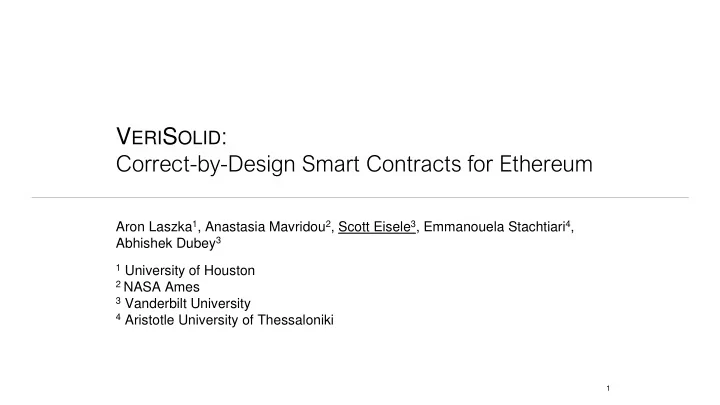

V ERI S OLID : Correct-by-Design Smart Contracts for Ethereum Aron Laszka 1 , Anastasia Mavridou 2 , Scott Eisele 3 , Emmanouela Stachtiari 4 , Abhishek Dubey 3 1 University of Houston 2 NASA Ames 3 Vanderbilt University 4 Aristotle University of Thessaloniki 1
Smart Contracts on Blockchains • Smart contract: general purpose computation on a blockchain (or other distributed ledger) based computational platform • Recently popularized by Ethereum • smart contracts may be developed using high-level languages, such as Solidity • enables the creation of decentralized applications • Envisioned to have a wide range of applications • financial (self-enforcing contracts) • Internet of Things • decentralized organizations • … 2
Transactive Energy Systems
Smart Contract Security in Practice • Notable incidents (amounts vary over time with variations in exchange rate) • The DAO attack : ~$500 million taken • Parity wallet freeze : ~$70 million frozen • Parity wallet hack : ~$21 million taken • Recent analysis: 34,200 contracts (out of 1M publicly deployed contracts) have security issues / vulnerabilities 1 • Distributed ledgers are immutable by design • smart contract vulnerabilities cannot be patched * • erroneous (or malicious) transactions cannot be reverted * * without undermining the trustworthiness of the contract / ledger 1 Ivica Nikolic, Aashish KolluriChu, Ilya Sergey, Prateek Saxena, and Aquinas Hobor, “ Finding the greedy, prodigal, and suicidal contracts at scale ,” ACSAC’18. 4
Securing Smart Contracts • Vulnerabilities often arise due to semantic gap • difference between assumptions that developers make about execution semantics and the actual semantics • Solidity resembles JavaScript, but it does not work exactly like • Existing approaches • design patterns, e.g., Checks-Effects-Interactions • tools for finding (typical) vulnerabilities • O YENTE • MAIAN • … • tools for verification and static analysis • S ECURIFY • R ATTLE • … 5
Correct-by-Design Contract Development feedback verification Contract Contract deploy model bytecode • Advantages of model-based approach • specification of desired properties with respect to a high-level model • providing feedback to developer with respect to a high-level model 6
V ERI S OLID Model • Formal, transition-system based language for contracts state • each contract may be represented as a transition system 7
V ERI S OLID Model • Formal, transition-system based language for contracts state • each contract may be represented as a transition system Definition : A smart contract is a tuple • D custom data types and events • S states • S F ⊂ S final states • s 0 ∈ S initial state • a 0 ⊂ initial action : subset of Solidity statements • a F ⊂ fallback action • V contract variables • T transitions (names, source and destination states, guards, actions, parameter and return types) implemented as functions in the generated code 8
V ERI S OLID Semantics • We define semantics in the form of Structural Operational Semantics • Basic transition rule: • transition t changes ledger state from Ψ to Ψ ’ and contract state from s to s ’ • We also define semantics for erroneous transitions (e.g., exceptions) and for supported Solidity statements • Transitions work “ as expected ” from a transition system * * with Solidity-related additions, such as exceptions and fallback functions 9
V ERI S OLID : Correct-by-Design Smart Contracts 10
V ERI S OLID : Correct-by-Design Smart Contracts 11
V ERI S OLID : Correct-by-Design Smart Contracts 12
V ERI S OLID : Correct-by-Design Smart Contracts 13
V ERI S OLID : Correct-by-Design Smart Contracts 14
V ERI S OLID : Correct-by-Design Smart Contracts 15
V ERI S OLID : Correct-by-Design Smart Contracts 16
V ERI S OLID Verification Process • First, transform a contract into an augmented transition system , which captures behavior using transitions • based on the formal operational semantics of supported Solidity statements Theorem: The original contract and the corresponding augmented transition system are observationally equivalent. • Second, transform an augmented transitions system into an observationally-equivalent Behavior-Interaction-Priority (BIP) model • Over-approximation of contract behavior • satisfied safety properties are satisfied by the actual contract • violated liveness properties are violated by the actual contract • Verification using nuXmv model checker satisfied properties + violated properties (with violating transition traces) 17
V ERI S OLID Verification • Instead of searching for vulnerabilities, we verify that a model satisfies desired properties that capture correct behavior • Deadlock freedom : contract cannot enter a non-final state in which there are no enabled transitions • Safety and liveness properties • specified using Computational Tree Logic (CTL) • we provide several CTL templates to facilitate specification AG ( Y → AG ( ¬ X )) X cannot happen after Y where X and Y can be transitions or statements • example: AG ( close → AG ( ¬ bid )) bid cannot happen after close 18
Example Model: Transactive Energy Market as a Transition System Violated Property Example If close happens , postSellingOffer or postBuyingOffer can happen only after offers.length=0 19
Conclusion V ERI S OLID advantages • high-level model with formal semantics (which are familiar to most developers) • verification of desired behavior (instead of searching for typical vulnerabilities) • high-level feedback to the developer (for violated properties) • Solidity code generation (instead of error-prone coding) • Future work : interactions between multiple contracts • Source code: http://github.com/anmavrid/smart-contracts Live demo at: http://cps-vo.org/group/SmartContracts (requires free registration) 20
Thank you for your attention! Questions? 21
Recommend
More recommend